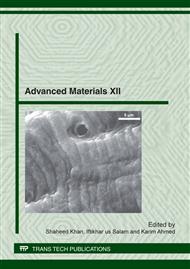p.330
p.335
p.343
p.348
p.356
p.364
p.371
p.378
p.386
Effect of Zirconium Addition on Welding of Aluminum Grain Refined by Titanium
Abstract:
Aluminum and its alloys solidify in large grains columnar structure which tends to reduce their mechanical behaviour and surface quality. Therefore, they are industrially grain refined by titanium or titanium + boron. Furthermore, aluminum oxidizes in ordinary atmosphere which makes its weldability difficult and weak. Therefore, it is anticipated that the effect of addition of zirconium at a weight percentages of 0.1% (which proved to be an effective grain refiner on the weldability of aluminum grain refined by Ti) is worthwhile investigating. This formed the objective of this research work. In this paper, the effect of zirconium addition at a weight percentage of 0.1%, which corresponds to the peritctic limit on the aluminum-zirconium phase diagram, on the weldability of aluminum grain refined by Ti is investigated. Rolled sheets of commercially pure aluminum, Al grain refined Ti of 3 mm thickness were welded together using Gas Tungsten Arc Welding method (GTAW), formerly known as TIG. A constant air gap was maintained at a constant current level, 30 ampere AC, was used because it removes the oxides of the welding process under the same process parameters. Metallographic examination of weldments of the different combinations of aluminum and its microalloys at the heat affected zone, HAZ, and base metal was carried out and examined for width, porosity, cracks and microhardness. It was found that grain refining of commercially pure aluminum by Ti resulted in enhancement of its weldability. Similarly, addition of zirconium to Al grain refined by Ti resulted in further enhancement of the weldment. Photomicrographs of the HAZ regions are presented and discussed.
Info:
Periodical:
Pages:
356-363
Citation:
Online since:
May 2012
Authors:
Price:
Сopyright:
© 2012 Trans Tech Publications Ltd. All Rights Reserved
Share:
Citation:


